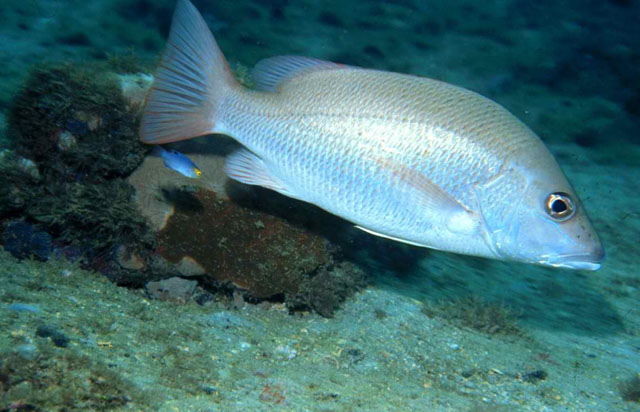| Lutjanidae (Snappers), subfamily: Lutjaninae |
| 80 cm TL (male/unsexed) |
|
reef-associated; freshwater; brackish; marine; depth range 0 - 50 m |
| Eastern Atlantic: west coast of Africa (Ref. 57393) from Senegal to Congo (Ref. 81653), primarily in the Gulf of Guinea and Cape Verde Islands (Ref. 57393, 81653). |
|
Dorsal spines (total): 10-10; Dorsal soft rays (total): 14-14; Anal spines: 3-3; Anal soft rays: 8-8. Diagnosis: body stocky (Ref. 57393), relatively deep (Ref. 81653). Head pointed, dorsal profile of forehead abrupt/steep (Ref. 55, 57393, 81653). Eyes large (Ref. 81653). Preorbital/lachrymal bone (very) broad (Ref. 55, 81653). Maxilla extending to about mid-eye level (Ref. 55, 57393, 81653). Vomerine tooth plate triangular with a pronounced, long, postero-median extension (Ref. 57393, 81653). Pectoral fins of adult not reaching level of anus (Ref. 55, 81653). Scales medium-sized and ctenoid (Ref. 57393, 81653). Scale rows on back parallel to lateral line (Ref. 55, 57393, 81653), 5-7 rows below spinous part of dorsal fin (Ref. 57393, 81653). 5-6 transverse scale rows on cheek (Ref. 55, 57393, 81653). Presence of narrow blue band from snout to angle of opercle (Ref. 55, 57393, 81653) or a row of broken spots below eye (ref. 55). Small specimens from shallow water mainly brownish (Ref. 55).
Coloration: back vermilion red, becoming bright pink in large individuals and fading progressively to whitish on belly; blue subocular line, either continuous or fragmented, running from upper jaw to angle of opercle; juveniles more or less uniformly brownish (Ref. 57393). |
| Adults occur on rocky bottoms and in the vicinity of coral reefs (Ref. 55, 57393, 81653). Young are frequently encountered in coastal waters, particularly estuaries and sometimes in lower courses of rivers (Ref. 2683, 57393, 81653). Voracious predator (Ref. 57393), feeds mainly on fishes and bottom-dwelling invertebrates (Ref. 55). Size of juveniles ranges from 7.90 to 19.99 cm in length (Ref. 111357). |
|
Data deficient (DD); Date assessed: 06 May 2013 Ref. (130435)
|
| harmless |
|
Source and more info: www.fishbase.org. For personal, classroom, and other internal use only. Not for publication.

